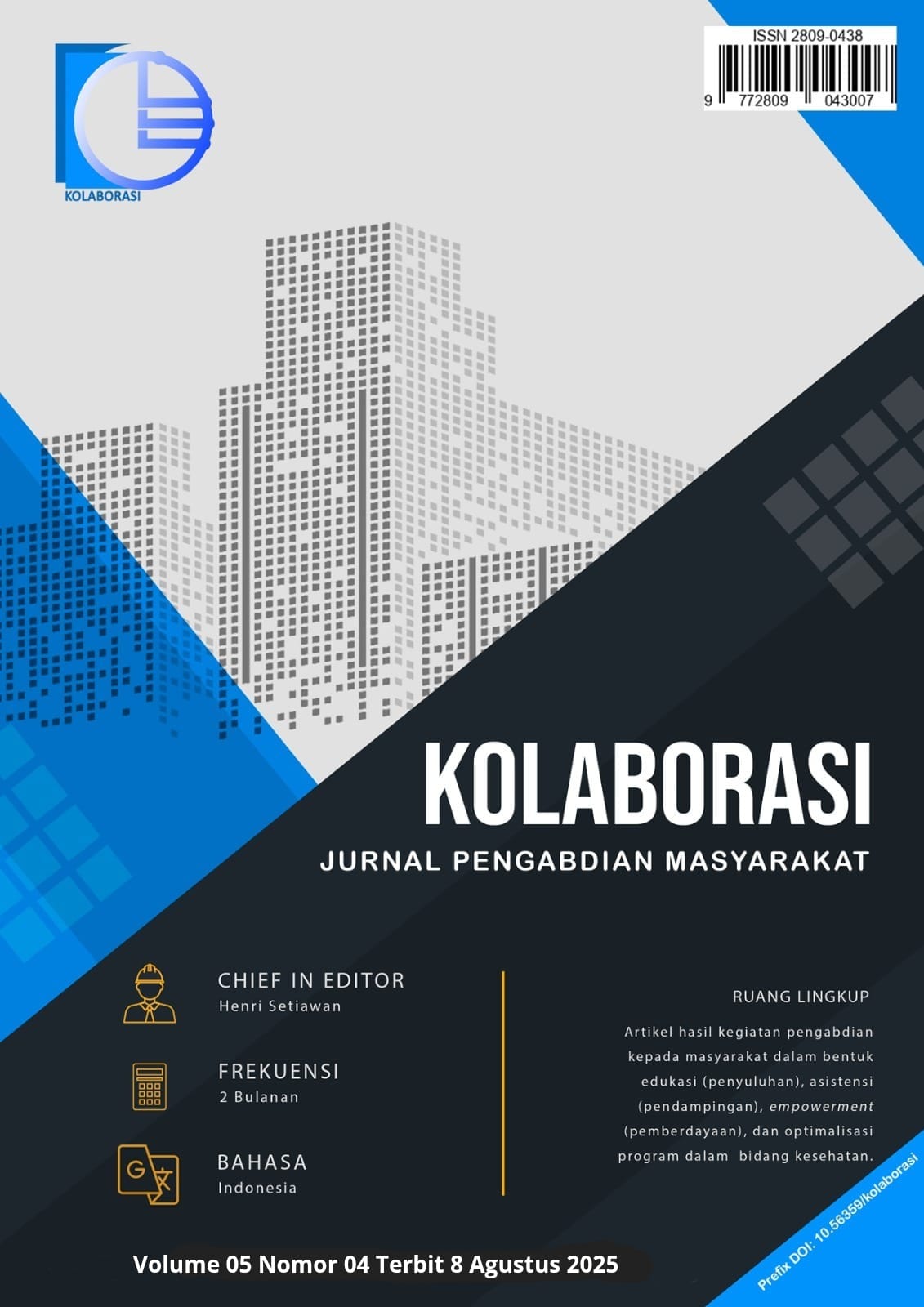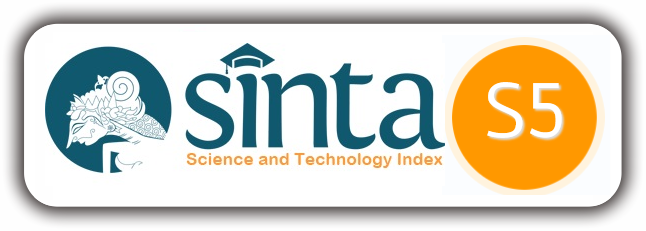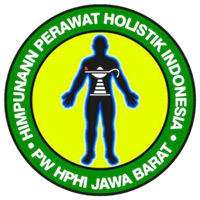Penyuluhan Demam Berdarah dan Pemanfaatan Pekarangan sebagai Strategi Pencegahan Berbasis Lingkungan
DOI:
https://doi.org/10.56359/kolaborasi.v5i4.557Kata Kunci:
dengue prevention, community participation, mosquito-repellent plants, environmental healthAbstrak
Introduction: Dengue Hemorrhagic Fever (DHF) continues to be a serious public health issue in Indonesia, including in Waru Village, Mranggen District, Demak Regency, where a rise in cases was recorded in 2024. Traditional prevention efforts such as the 3M campaign (draining, covering, and burying) and fogging have not been fully effective in reducing case numbers. This community engagement program aimed to enhance DHF prevention efforts by combining health education with the ecological use of home yards through the cultivation of mosquito-repellent plants. Method: The program was conducted by the KKN team from UIN Walisongo Semarang using a Participatory Action Research (PAR) approach, which involved active collaboration with PKK cadres and local residents. The implementation consisted of three stages: preparation, core activities (education and planting), and post-activity evaluation. Data were collected through observations, interviews, documentation, and reflective discussions with the community. Results: showed increased public awareness and participation in environmental hygiene practices. Residents expressed a better understanding of natural mosquito control methods and began planting and maintaining useful plants such as aloe vera (Aloe barbadensis), lemongrass (Cymbopogon citratus), and citrus (Citrus sinensis) in their yards. Interviews revealed positive behavioral changes and a collective commitment to sustaining these efforts. Conclusion: this program demonstrates that integrating health education with participatory environmental action can effectively strengthen community-based DHF prevention strategies and promote long-term behavioral change.
Unduhan
Referensi
Arlinta, D. (2024). Deaths from Dengue Fever were Higher at the Beginning of This Year. Kompas.Com. https://www.kompas.id/baca/english/2024/03/04/en-kematian-akibat-demam-berdarah-pada-awal-tahun-ini-lebih-tinggi
Aseptianova, A., Wijayanti, T. F., & Nurina, N. (2017). Efektifitas Pemanfaatan Tanaman Sebagai Insektisida Elektrik Untuk Mengendalikan Nyamuk Penular Penyakit Dbd. Bioeksperimen: Jurnal Penelitian Biologi, 3(2), 10–19. https://doi.org/10.23917/bioeksperimen.v3i2.5178
Ashiyam, I. N., Safitri, I., Sholikhah, N. L., Nugraheni, N. M., Hidayanti, L., Alifah, F., Khusnurrijal, K., Triastati, T., Udiyono, U., Widodo, L. B., Khafiyurrohman, M., Lutfi, M., Arrosyid, K. H., & Lestarini, W. (2025). Pemanfaatan Tanaman Serai sebagai Obat Pengusir Nyamuk untuk Pencegahan DBD Mandiri di Desa Tegalrejo. Jurnal Edukasi Pengabdian Masyarakat: EDUABDIMAS, 4(1), 175–182. https://doi.org/10.36636/eduabdimas.v4i2.6596
Baum, F., MacDougall, C., & Smith, D. (2006). Participatory action research. Journal of Epidemiology and Community Health, 60(10), 854–857. https://doi.org/10.1136/jech.2004.028662
Boyer, S., Lopes, S., Prasetyo, D., Hustedt, J., Sarady, A. S., Doum, D., Yean, S., Peng, B., Bunleng, S., Leang, R., Fontenille, D., & Hii, J. (2018). Resistance of Aedes aegypti (Diptera: Culicidae) Populations to Deltamethrin, Permethrin, and Temephos in Cambodia. Asia-Pacific Journal of Public Health, 30(2), 158–166. https://doi.org/10.1177/1010539517753876
Cornish, F., Breton, N., Moreno-Tabarez, U., Delgado, J., Rua, M., Aikins, A. de-G., & Hodgetts, D. (2023). Participatory action research. Nature Reviews Methods Primers, 3(34). https://doi.org/10.1038/s43586-023-00214-1
Felani, E., Istiqomah, K. F., Sari, I. N. I., & Hidayatullah, R. (2025). Implementasi Strategi Participatory Action Research (PAR) untuk Mengoptimalkan Pengelolaan Sampah Berbasis Sekolah: Sebuah Pendekatan Inovatif dan Berkelanjutan. An Najah (Jurnal Pendidikan Islam Dan Sosial Keagamaan), 4(3), 21–27.
Gan, S. J., Leong, Y. Q., bin Barhanuddin, M. F. H., Wong, S. T., Wong, S. F., Mak, J. W., & Ahmad, R. B. (2021). Dengue fever and insecticide resistance in Aedes mosquitoes in Southeast Asia: a review. Parasites and Vectors, 14(315), 1–19. https://doi.org/10.1186/s13071-021-04785-4
Ghosh, A., Chowdhury, N., & Chandra, G. (2012). Plant extracts as potential mosquito larvicides. Indian Journal of Medical Research, 135(5), 581–598.
Hanifia, P., Kusumawaty, W. W., Kurniawati, N., & Muhshi, M. A. (2025). Kabupaten Demak dalam Angka 2025. In BPS Kabupaten Demak (Vol. 49). https://demakkab.bps.go.id/id/publication/2025/02/28/aa73744a55d7df8df2e6a2f2/kabupaten-demak-dalam-angka-2025.html
Hidayah, N., Herawati, A., & Habibi, A. (2019). Identifikasi Kandungan Fitokimia Ekstrak Bunga Melati (Jasminum sambac (L.)ai) Komoditas Lokal yang Berpotensi Sebagai Antilarvasida. Dinamika Kesehatan Jurnal Kebidanan Dan Keperawatan, 10(1), 476–483. https://doi.org/10.33859/dksm.v10i1.450
Innocent, E., Hassanali, A., Kisinza, W. N. W., Mutalemwa, P. P. P., Magesa, S., & Kayombo, E. (2014). Anti-mosquito plants as an alternative or incremental method for malaria vector control among rural communities of Bagamoyo District, Tanzania. Journal of Ethnobiology and Ethnomedicine, 10(56). https://doi.org/10.1186/1746-4269-10-56
Rasli, R., Lee, H. L., Ahmad, N. W., Fikri, S. F. F., Ali, R., Muhamed, K. A., Hadi, A. A., Liu, Q. Y., & Meng, F. X. (2018). Susceptibility Status and Resistance Mechanisms in Permethrin-Selected, Laboratory Susceptible and Field-Collected Aedes aegypti from Malaysia. Insects, 9(2), 1–17. https://doi.org/10.3390/insects9020043
Setiyawan, H., Lestari, A. S., Ayuningtyas, E. N., Meradji, A., Diana, E., & Utami, E. B. (2019). Penyuluhan Demam Berdarah Dengue (DBD) dan Tanaman Pengusir Nyamuk Di Desa Modalan, Banguntapan. Jurnal Pemberdayaan: Publikasi Hasil Pengabdian Kepada Masyarakat, 3(2), 241–244. https://doi.org/10.12928/jp.v3i2.849
Syamsiah, S., Arsal, A. F., Kurnia, N., & Hamka, L. (2022). Pengenalan Tanaman Anti Nyamuk dalam Pencegahan Demam Berdarah. INOVASI: Jurnal Hasil …, 2(1), 44–51. https://ojs.unm.ac.id/inovasi/article/view/34131
Waterman, S. H., & Gubler, D. J. (1989). Dengue Fever. Clinics in Dermatology, 7(1), 117–122. https://doi.org/https://doi.org/10.1016/0738-081X(89)90034-5
Wiwanitkit, V. (2010). Dengue fever: diagnosis and treatment. Expert Review of Anti-Infective Therapy, 8(7), 841–845. https://doi.org/10.1586/eri.10.53
Yunus, R., Supiati, S., & Nurtimasiah, W. O. (2024). Edukasi Pencegahan Penyakit Demam Berdarah Dengue dan Optimalisasi Pemanfaatan Tanaman Berpotensi Penolak Vektor Penular DBD. Jurnal Inovasi Pemberdayaan Dan Pengabdian Masyarakat (JIPPM), 4(2), 45–53. https://doi.org/https://doi.org/10.36990/jippm.v4i2.1535
Unduhan
Diterbitkan
Cara Mengutip
Terbitan
Bagian
Lisensi
Hak Cipta (c) 2025 Anugallakata Nea Sasgapata Kurniawan, Ilham Kharullah, Naili Sa'adah, Umi Kholifah, Rizky Annisa' Azizah, Zamilatul Mila, Putri Rahmawati, Nada Nasywa Shabrina, Evita Ayu Andriyani, Muhammad Nouval Raya Fahreza, Nur Shifiya Munashiva, Nabila Mega Wangi, Sofyya Agustina, Asya Ainu Septian, Fadhilatul Qoniah, Fatkhi Zalfa Perdana

Artikel ini berlisensi Creative Commons Attribution 4.0 International License.












